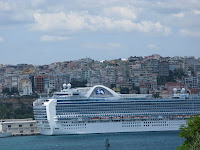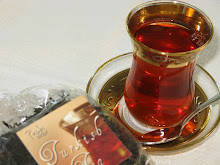Thursday, July 30, 2009
Back to the old grind
Today I went back for my first full day of work since our return from Turkey. All the speciaists, several secretaries, and a couple of supervisors were so impressed with what I have learned about the Turkish art of water marbling that they asked me to teach them how to do it. Ayla Makas, the ebru instructor does not offer brushes or paints for sale on her website (www.aylamakas.com). I'll have to begin searching for the necessary materials.
Tuesday, July 28, 2009
Mercimek Corbasi
All went well yesterday until we reached JFK. Due to inclement weather, flights were delayed and cancelled. My flight from JFK to Norfolk was delayed two hours as was Jim Hauf's to St. Louis, but, what a relief to finally board the aircraft! After 30 minutes on the runway I overheard another passenger grumble, "Are we planning to taxi all the way to Norfolk?"
Actually, I walked through the door of our house at 3 o'clock in the morning. In Istanbul it ws already 10 o'clock in the morning. I decided to stay up, unpack my luggage, and do laundry. As soon as Tony left for work, I went to the grocery store. The abbreviated version of this story is that I purchased the ingredients for soup and prepared mercimek corbasi for dinner. Nothing hits the spot like good Turkish soup. I'll include the recipe that I used (to which I added additional mint and paprika) from TURKISH COOKING (ISBN 978-975-7199-76-2) :
MERCIMEK CORBASI (red lentil soup)
1 large chopped onion (red)
2 carrots
1 large potato
1 glass red lentils (1 cup)
6 glasses vegetable broth (6 cups)
1 T butter
1/4 glass of cream (1/4 cup whipping cream)
salt and pepper to taste
1/2 T butter
1/2 T dried mint
1/2 tsp paprika
2 T melted butter
Place onion, carrots, and potato in pressure cooker for about 10 minutes to soften. Add lentils, broth, seasoning, and mint. Cook over low heat stirring from time to time. (Remove from burner.) Add cream and blend with food processor. Season to taste (additional mint and paprika). Return to pan and simmer for a few minutes. Garnish and serve.
Actually, I walked through the door of our house at 3 o'clock in the morning. In Istanbul it ws already 10 o'clock in the morning. I decided to stay up, unpack my luggage, and do laundry. As soon as Tony left for work, I went to the grocery store. The abbreviated version of this story is that I purchased the ingredients for soup and prepared mercimek corbasi for dinner. Nothing hits the spot like good Turkish soup. I'll include the recipe that I used (to which I added additional mint and paprika) from TURKISH COOKING (ISBN 978-975-7199-76-2) :
MERCIMEK CORBASI (red lentil soup)
1 large chopped onion (red)
2 carrots
1 large potato
1 glass red lentils (1 cup)
6 glasses vegetable broth (6 cups)
1 T butter
1/4 glass of cream (1/4 cup whipping cream)
salt and pepper to taste
1/2 T butter
1/2 T dried mint
1/2 tsp paprika
2 T melted butter
Place onion, carrots, and potato in pressure cooker for about 10 minutes to soften. Add lentils, broth, seasoning, and mint. Cook over low heat stirring from time to time. (Remove from burner.) Add cream and blend with food processor. Season to taste (additional mint and paprika). Return to pan and simmer for a few minutes. Garnish and serve.
Istanbul - Dinner at Midpoint - July 25, 2009


Susan Dardar, Susan Bauer Gaina, Cynthia Helms, and I had dinner together on the rooftop terrace of Midpoint, a trendy restaurant just a few steps away from the Richmond Hotel on Istiklal in Istanbul. What a view overlooking the Bosphorus and Topkapi Palace! They ordered pasta. Mine was a whole plate of grilled vegetables!
We saw other Fulbrighters as we looked around at all of the beautiful (mostly young) people talking, laughing, and smoking fashionably (allowed outdoors). With an unobstructed view beside the railing sat Sue Graham, Kerry, Sarah, and Tim. Sue and Sarah spoke with us as they were leaving. Sue noted that she'd purchased another garment (for teaching purposes) from the same guy in the bazaar who had sold her the lovely red caftan that she had shown us earlier in the hotel lobby. Sarah said she hadn't eaten much dinner in that she'd been "under the weather" all day and had remained in her hotel room. Of course, she seemed excited to have a few extra days with Tim to explore Istanbul.
Knowing that we had packing to complete, we reluctantly gathered our belongings and prepared to leave the rooftop dining terrace when we spied Martha and Julie V. who had come here for dinner after drinks elsewhere. Like us, they were trying to take in the breathtaking view before returning to the mundande chore of packing.
Saturday, July 25, 2009
Ebru Instruction, Caferaga Medresesi, Istanbul










This special class that Secil Yazicioglu, Fulbright program administrator, arranged and for which we had to pay an additional amount turned out to be one of the highlights of the entire Fulbright Turkey experience. The taxi driver, whose regular job is teaching insurance courses, could drive us only so far to a labyrinth of cobblestone streets behind Ayasofya. We walked until we found Caferaga Medresesi, constructed in 1559 by the famous Turkish architect named Sinan. The school consists of 15 classrooms/exhibition rooms constructed of various stones and marble around a peaceful garden that also serves as an outdoor cafe. In addition to instruction in ebru, courses are offered in the historical arts of calligraphy, miniature painting, jewelry making, tile and porcelain making, glass painting, and music (including stringed instruments like the balgama).
Ebru is a traditional water marbling art that is known to have been practiced in Anatolia at least 500 years ago. Using special horsehair brushes, the marbler sprinkles earth dyes that contain ox gall over water that has been treated with gum tragacanth. By simply placing paper over the design and carefully pulling it across the edge of the tray, the design is transferred to paper.
Patient and experienced, Ayla Makas, our lovely ebru teacher at Caferaga Medresesi, guided Cynthia Helms, Susan Bauer Gaina, and Linda Harkins through the steps of the water marbling process--ebru--that could result in the production of decorative paper used as end papers for bound books. Ayla also hepled each of us design a Turkish tulip over a blue marble background. Each result is lovely enough to frame.
While I purchased two additional sheets of ebru made by medresesi artisans, Susan and Cynthia shopped for ceramics. In fact, Cynthia will take home six gorgeous mugs designed with the Iznik tulip motif. Ayla also provided her Web site address: www.aylamakas.com
Friday, July 24, 2009
Bogazici University, Istanbul





Author Orhan Pamuk describes the dog packs in Istanbul neighborhoods. Rather than dogs we've encountered cats galore! One of these huge felines jumped onto our outdoor table as we were finishing lunch.
Bogazici (bo-ah-zee-che) University (BU) may have been selected for us to visit due to a combination of factors. First, it is situated in a lovely setting overlooking the Bosphorus in a different part of Istanbul from where we are staying. Faculty and students alike enjoy this campus. Next, we were informed that it originated as Robert College in 1863--the first American college established outside the continental US. A Christian liberal arts institution, it became a public Turkish college in 1971. It remains comparatively small with an enrollment of 11,000 total,8587 undergraduates. Although selective, BU allows undergrads to take up to 14 semesters (7 years) to complete their degrees. The first year is usually a concentration in English language learning with the first semester at the Black Sea campus. Everyone prefers the utopian Istanbul campus.
After our campus tour, we stopped at an upscale mall for about an hour. What a beautiful shopping mall! In one of the stores we saw dresses that looked exactly like something Secil would select.
We had a few hours back in our hotel before the evening event: our Fulbright farewell party at a dinner theater where we were entertained through song, dance, and instrumental music.
Thursday, July 23, 2009
Princes' Islands and quick trip back to bazaar





We took the public ferry out in the Sea of Marmara and disembarked at the fourth stop onto a tiny resort island. We took horse-drawn carriages to the incline leading to a tiny church. Lunch was served at the summit. The ferry returned in 90 minutes to Istanbul. We had just enough time to walk to the spice market before closing.
Wednesday, July 22, 2009
Topkapi Palace and Archaeological Museums of Istanbul











This museum complex consists of three collections housed in separate buildings. The main building, in neoclassical style, houses sarcophagi. As its name implies, the Tile Pavilion, featuring Ottoman civil architecture, houses a collection of Turkish and Islamic tiles. The third is the Museum of Oriental Antiquities.
Lines were long as visitors poured into Topkapi Palace from three cruise ships. What is now a museum once served as the royal residence for the sultan, his court and harem, and was also the center of state administration. We were fortunate to be able to watch an outdoor performance of the Imperial Band and to enjoy lunch at the restaurant on the grounds. The sultan's kitchens, currently closed to the public, originally prepared food for 4,000 on a daily basis. I'll bet the restaurant's efficient waiters served that many guests today, too.
Tuesday, July 21, 2009
Dolmabahce Palace, Chora Museum, Pierre Loti Cafe






We visited magnificent Dolmabahce ("stuffed garden") Palace on the Bosphorus this morning that Ataturk decreed to be turned into a museum. It is estimated that the amount of gold used in the inner ornamentaion of the palace equals three tons. The glorius Muayede Lounge with its gilded ceiling, five-ton crystal chandelier, and largest one-piece carpet in the world remains as impressive today as it was when it was used to welcome important guests to Turkey.
Lunch was in a fundamentalist area of the city at a restaurant called Kiztasi. For dessert, we enjoyed helva, a new taste experience for most of our group.
A visit to Chora ("countryside") museum followed lunch. Its magnificent mosaics and frescoes date from the 14th century.
For a view of the Golden Horn, we stopped at Pierre Loti Cafe for cay. The views were spectacular, and the breeze invigorating. A family celebrated the impending circumsion of their son, a boy dressed in princely clothing.
Subscribe to:
Posts (Atom)












